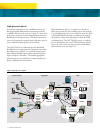
Alcatel-Lucent 1850 TSS-100 5
The universal switch
The Alcatel-Lucent 1850 TSS-100 offers operators a
powerful tool for operating future-safe transport networks,
with total freedom in planning network resources to support
the delivery of new broadband applications such as triple
play, video, mobile and Ethernet business services. It also
ensures seamless interworking with the legacy transport
assets that support existing revenues, while fully addressing
the optical-packet transport convergence, as demanded by
operators. This offers the following advantages:
•SupportsanymixofEthernet,TDM,WDM,OTNand
future services with only a simple change of interface
cards, eliminating the need for future switch investments
as new services or protocols emerge.
•Offersatechnology-independentuniversalswitch,
capable of switching packets or circuits in their native
format and transporting them as they are, without costly
mapping of circuits into packets or packets into circuits.
The universal switch provides scalable switching capacity
regardless of the traffic type.
•Deliverstechnology-dependentlinecards,packet,circuit
or wavelength, where traffic is properly processed according
to its native format. The line cards provide native
traffic processing.
•Eliminates,byinnovativelydemarkingbetweentrafc
processing and traffic switching, the cost penalties
traditional transport-node architectures incur with
their technology-dependent processing performed in
the switch (matrix). Packet and TDM traffic processing
resides on the relevant line cards, allowing gradual
investment to meet growing traffic requirements.
The concept of a single transport-aggregation platform
is a breakthrough in operator networking. Instead of
investing in several network layers to provide the required
service mix, operators can now choose one platform
that delivers all services. By deploying the 1850 TSS-100
as a unified transport platform supporting any mix of
services, operators can:
•Simplifynetworkoperations,signicantlyreducing
operating expenditures (OPEX) and increasing the
network flexibility and scalability
•Lowertheriskofcapitalexpenditures(CAPEX)invest-
ments that may vary over time, depending on service-
demand changes
•Shortentime-to-revenuefornewservices














